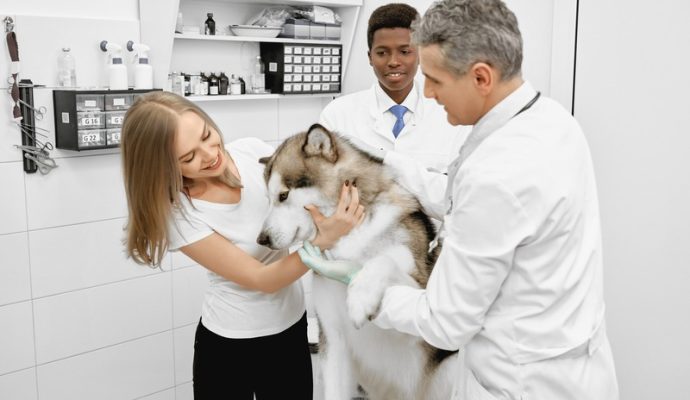We often hear about the importance of maintaining good dental hygiene for ourselves, but how often do we consider the dental health of our pets? Just as with humans, maintaining proper dental care is critical for the overall health and well-being of our furry friends. From preventing painful dental diseases to warding off potential secondary health issues, diligent oral hygiene for your pet cannot be overlooked.
Impact of Poor Dental Hygiene on Your Pet’s Health
1. Bad Breath as a Warning Sign
While bad breath in pets might be dismissed as a common aspect of ownership, it can serve as a crucial warning sign. Persistent bad breath often indicates underlying dental issues that require attention.
2. Progression from Plaque to Tartar
Poor dental hygiene sets the stage for the accumulation of plaque on your pet’s teeth. If left untreated, this plaque can progress to tartar, a hardened and more stubborn form of dental buildup that is challenging to remove through regular brushing.
3. Development of Gingivitis
Tartar buildup contributes to the development of gingivitis, an inflammation of the gums. Gingivitis can cause redness, swelling, and discomfort for your pet. At this stage, intervention is necessary to prevent further progression of dental issues.
4. Escalation to Periodontal Disease
Untreated gingivitis can escalate to periodontal disease, a more severe condition that affects the structures supporting the teeth. This can include damage to the gums, ligaments, and even the jawbone, leading to increased pain and potential tooth mobility.
5. Tooth Loss and Discomfort
The ultimate consequence of untreated dental problems is tooth loss. This not only impacts your pet’s ability to eat but can also cause considerable pain and distress. Tooth loss affects their overall quality of life, including their ability to enjoy food and engage in normal activities.
6. Pain and Distress
Dental issues, especially advanced periodontal disease, can cause significant pain for your pet. Pets may experience discomfort while eating, reluctance to play with toys, and behavioral changes. Addressing dental problems promptly is essential to alleviate pain and improve their well-being.
7. Impact on Quality of Life
Poor dental hygiene has a direct impact on your pet’s quality of life. Painful dental conditions can lead to changes in behavior, reduced activity levels, and overall discomfort. Regular dental care, including professional cleanings and home maintenance, is crucial for preserving your pet’s oral health and overall happiness.
The Domino Effect of Dental Diseases
When bacteria from the mouth enter the bloodstream, they can travel to other organs, potentially creating severe health issues. These bacteria can cause infections in the heart, liver, and kidneys. Therefore, a healthy mouth often equates to a healthier pet overall.
Risk of Oral Infections and Tooth Loss
Infections that begin in the mouth don’t always stay localized. If left untreated, these infections can spread, leading to a necessity for antibiotics or, in severe cases, surgical intervention. Additionally, significant tooth decay and periodontal disease frequently lead to tooth loss, making eating a painful and challenging ordeal for your pet.
Understanding Pet Dentistry and Dental Surgery
If your pet’s oral health issues cannot be resolved with routine cleaning and care, it might be time to consult with a specialist in pet dentistry and dental surgery. Dental surgeries can range from simple extractions to more complex procedures such as root canals or jaw repairs. In these instances, finding a reliable animal dentist near me can be an invaluable step in restoring and maintaining your pet’s dental health.
Preventive Measures to Ensure Dental Health
Prevention is always better than cure, and this is especially true for dental care in pets. Routine dental check-ups are essential, but there are several things you can do at home to maintain your pet’s dental hygiene.
- Regular Brushing: Brushing your pet’s teeth several times a week can help prevent plaque and tartar buildup.
- Dental Treats: Dental treats are formulated to help reduce tartar and freshen breath, offering a supplemental way to maintain oral health.
- Special Diets: Some pet foods are designed to support dental health by reducing plaque and tartar formation.
Spotting the Signs of Dental Problems in Pets
- Bad Breath: Persistent bad breath is often an early indicator of dental issues in pets. If your pet’s breath consistently has an unpleasant odor, it’s advisable to schedule a veterinary examination to assess their dental health.
- Excessive Drooling: Unusual drooling, especially if it’s excessive or not typical for your pet, can be a sign of oral discomfort. If drooling is persistent or out of the ordinary, it’s a red flag that warrants a visit to the vet for a comprehensive dental check-up.
- Difficult or Slow Eating: Changes in eating behavior, such as difficulty or slowness while eating, may indicate pain or discomfort associated with dental problems. Monitor your pet’s eating habits closely; if you notice any reluctance or changes, consult with your veterinarian promptly.
- Pawing at the Face or Mouth: Pets experiencing oral pain may paw at their face or mouth in an attempt to alleviate discomfort. Persistent pawing or sensitivity in the facial area is a clear signal to seek professional veterinary advice to assess and address potential dental issues.
- Red or Swollen Gums: Inflammation of the gums, indicated by redness or swelling, is a visible sign of potential dental problems. Regularly check your pet’s gums for any signs of inflammation. If present, consult your veterinarian for an evaluation.
- Changes in Chewing Habits: A shift in chewing behavior, such as favoring one side of the mouth or avoiding certain types of food, can suggest dental discomfort. Pay attention to any alterations in chewing habits and discuss these changes with your vet during routine check-ups.
- Tooth Discoloration or Visible Tartar: Discoloration of teeth or the presence of visible tartar can indicate dental issues. Regularly inspect your pet’s teeth for any abnormalities. If you notice discoloration or significant tartar buildup, consult with your veterinarian for appropriate dental care.
The Role of Other Veterinary Services
Despite your best efforts, your pet’s dental care isn’t complete without the expertise of veterinary professionals. Regular dental check-ups and cleanings are vital to catch issues early on and provide necessary treatments.
Consulting a Veterinary Surgeon
For more advanced dental issues, a consultation with a veterinary surgeon may be required. These professionals can perform more complex procedures beyond a standard dental cleaning. For example, should your pet require any oral surgery, such as tooth extractions or tumor removal, these surgeons are the go-to specialists. Should you find your pet in need of such attention, always ensure you check over here for a qualified and reputable professional.
Dental Care in Your Pet’s Regular Grooming Routine
While dental care might seem separate from grooming, integrating it into your pet’s overall grooming routine can prove beneficial. This can include regular inspections of your pet’s teeth and gums while you bathe, brush, or trim their coat. For a more detailed approach to grooming and specific dental handling, you may want to find out more about integrating these practices effectively.
Conclusion
Maintaining your pet’s dental health is an ongoing process that requires attention, dedication, and love. By being proactive, recognizing the signs of dental issues, and seeking appropriate care, you can ensure that your pet enjoys a long, happy, and healthy life.




